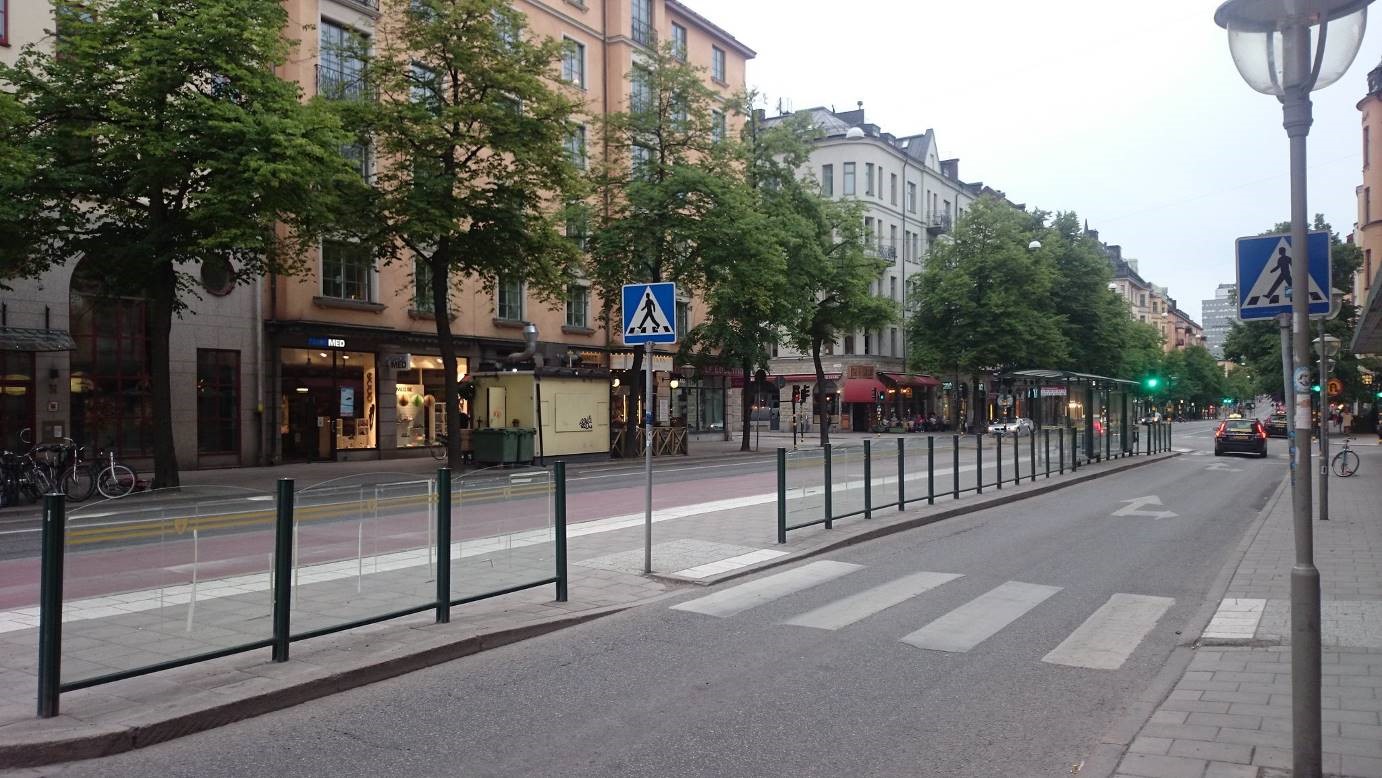Public transportation in the District of Columbia has been in meltdown for several years. The Post has a page aggregating Metrorail breakdown stories; in 2016, Metrorail ridership fell by about 6%. The buses have not fared any better. Where Metrorail’s problems are about breakdowns and safety, the buses’ are about network design. That is puzzling: unlike Metrorail tunnels, bus routes are relatively easy to move.
The good news is that the United States and Canada are replete with examples of good bus network redesigns. These redesigns are not game-changers the way the construction of Metrorail was, but they can accommodate more ridership with the same resources. In Seattle, the opening of a light rail extension last year led to a bus network redesign in the affected area, in which buses were reconfigured to serve the new stations. In Houston, a from-scratch redesign seems to have resulted in steady ridership in 2016, avoiding the declines seen by most other American bus agencies. D.C. can join the ranks of cities that have strengthened their bus systems to more effectively and efficiently serve their residents by following industry best practices, such as making schedules easier for passengers to follow and changing how routes run through downtown, among other changes.
There is a set of guidelines for how to run the best possible urban bus network. Some are general principles, applicable in nearly all developed-world cities, regardless of local details. They often involve cooperation between different agencies. For changes involving Metrorail, Metrobus, and other parts of the metro system, even straightforward changes might be difficult to implement; WMATA’s multi-jurisdictional nature means that regional leaders, both within the District and in Maryland and Virginia, need to work together on better system-wide integration. Other changes may only require the cooperation of DDOT and other agencies within the D.C. government.
1. Schedules should be frequent, and easily usable by riders.
Not every bus has to have high frequency, but there should be a useful network of lines with high frequency all day, working alongside Metro. When possible, schedules should run on a clockface pattern. A good example comes from the 52-54 buses running on 14th Street: in the midday off-peak period, each of the three buses comes every 20 minutes, in a precisely repeating schedule. Southbound, the 52 leaves Colorado Street and 14th at :16, :36, and :56 (that is, 16, 36, and 56 minutes past the hour); the 53 does at :09, :29, and :49; and the 54 does at :04, :24, and :44. This repeats for several hours, and passengers can memorize these patterns relatively easily. But this pattern breaks down at rush hour, even though WMATA can run twice as much service at the half points (e.g., at :06, :26, and :46) on the 52. A predictable schedule is also absent from other workhorse bus routes in D.C., such as the S2 and S4 on 16th, which instead come in 16-minute intervals in off-peak times.
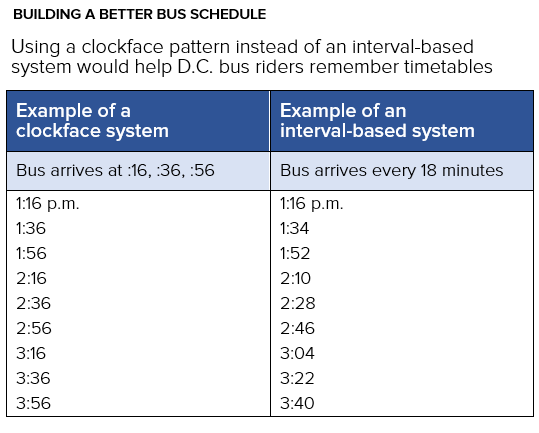
Other details depend on the city’s geography. While Boston has a tangled, unplanned street network, cities such as Chicago and Los Angeles have large-scale street grids, and their buses just follow the grid arterials. D.C. does have a grid, but it is not continuous through the entire city: the Anacostia River and Rock Creek Park both interrupt it, and it’s crisscrossed by diagonal avenues named after the states. There are only three crosstown crossings of Rock Creek Park (the 96/L2, the E series, and the H series); one of the most frequent buses, the 90, runs crosstown, but stops just short of Rock Creek and does not connect to the Red Line at Woodley Park.
2. Simplify bus routes, and reduce branching
On a radial route, connecting the center with outlying neighborhoods, there are two kinds of branching: conventional branching, which occurs at the outer end, and reverse branching, which occurs at the inner end. On Metro, the branching between the Yellow and Green Lines is conventional, as is the branching between the Orange, Silver, and Blue Lines: the various lines serve different destinations in the suburbs, but function as a single line through the center of the city. On the other hand, the branching between the Blue and Yellow Lines is reversed: The two lines run along the same route in the southernmost section of their route, but part ways upon reaching the city. Conventional branching makes sense in many cases, as it maximizes the intensity of service in the core, where there is the most demand—whereas reverse branching maximizes the intensity of service farther out and disperses it in the core (almost never a good idea).
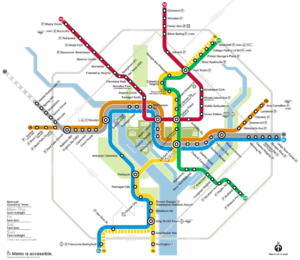
The relationship between Metrorail’s Yellow and Green lines is a form of traditional branching, while the relationship between the Yellow and Blue lines is a form of reverse branching.
Running public transit with traditional branches is a double-edged sword. On the one hand, it covers more area, and gives passengers a greater variety of one-seat rides—that is, trips that they can take without transferring to another bus or train. For example, riders in Alexandria benefit from being able to choose between the Yellow and Blue Lines. On the other hand, it limits the frequency of service: neither the Blue nor the Yellow Line runs very frequently outside rush hour. Branching also makes trains less reliable (compare London’s highly branched Northern line with the non-branching Jubilee and Victoria lines), which reduces capacity in turn.
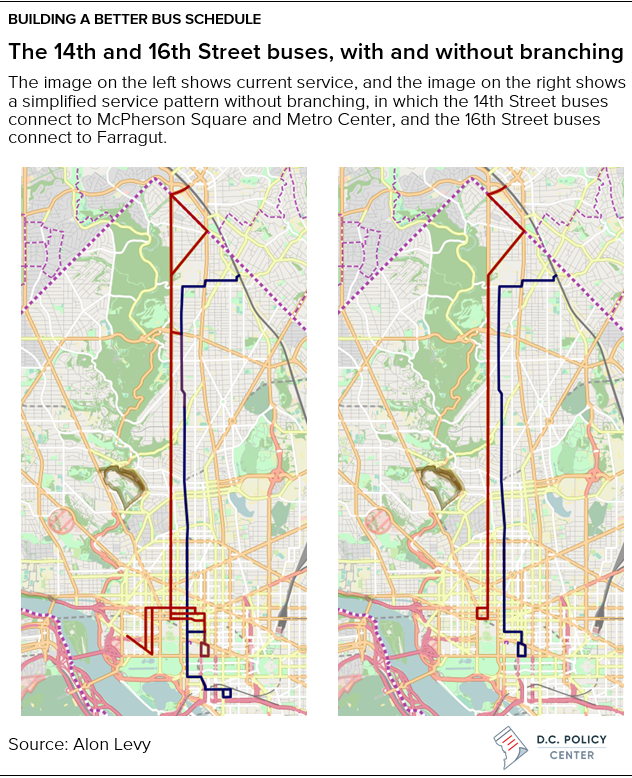
The buses in D.C. have extensive branching, of both kinds. The reverse branching on the 14th and 16th buses (the S-series and the 50-series) is especially frustrating. Those two streets have simple bus service, except at the downtown end, where three different branches serve different downtown destinations. The top destination for riders in D.C. is the central business district, from Farragut to Metro Center, and for other destinations passengers could connect to Metro. The 50-series could run every 6 minutes and the S-series every 7.5 minutes.
A bus that comes as frequently as every 6 minutes does not need to run on a timetable—achieving the required precision is hard on surface streets, and it is better to dispatch buses to run about 6 minutes behind the previous bus to even out bus load. And, with buses running so frequently, riders don’t need to memorize a specific schedule. But because the 50- and S-series buses are highly-branched, they have to run on a fixed schedule, since every individual branch only runs every 16 or 20 minutes; to achieve the same level of reliability, the timetables need to include padding, which further contributes to longer wait times. Pruning branches may look like a service cut on the map, but I would argue that the positive effects on frequency and reliability make it a service improvement overall, and may ultimately attract more riders over time.
3. Give the buses clearer route numbers
Good bus service is not just about technical decisions but also clarity in communicating the system to the passenger. All modern bus systems have inherited complex routes, legacy of when they were first established in the early 20th century. Over the decades, they have expanded haphazardly based on local changes, such as new development, or traffic changes that converted two-way streets to one-way. The resulting layout sometimes works and sometimes does not.
The bus grids of such cities as Los Angeles and Portland are recent creations, replacing old downtown-centric maps, inherited from an era where employment was more downtown-centric than today. These grids offer good connections between buses but also improve clarity: it is easier for passengers to know where the bus goes if it follows a familiar arterial road.
A more concrete example of how bus networks are typically kludges is route numbers. D.C.’s bus route numbers are a legacy of the 1930s, when the numbered routes were streetcars and the lettered routes were buses. Today, when all of these routes are buses, this naming system is no longer relevant and only introduces more complexity into the system. The S-series and 50-series routes are especially confusing, since the number 5 and the letter S look similar, and those buses run closely parallel to each other.
In some gridded cities with numbered streets, buses are numbered after the streets they run on. Thus, in Manhattan, the crosstown bus routes carry the number of the street they follow, such as 14th, 34th, or 42nd Street. Regardless of whether WMATA chooses to straighten the bus routes, it could streamline the bus nomenclature, to avoid the confusing coming from the lettered and numbered buses in the District; the new system should have a single route running down 14th, numbered 14, and another single route running down 16th, numbered 16.
4. Increase bus speed with off-board fare collection, dedicated bus lanes, and signal priority
Off-board fare collection, in which passengers generally purchase their tickets before they get on the bus, is one way of increasing bus speed. In German cities, for example, buses have off-board fare collection, with random fare inspections. Passengers who have valid monthly passes or transfers can board from any door; passengers who need to buy a ticket can board from the front and pay, but in practice those are a minority. This speeds up buses, since passengers can board more quickly. In the United States, San Francisco Muni is to date the only American agency to have implemented this systemwide, gaining 2% speed with a 2% rise in passenger numbers, where normally rising passenger usage would lead to lower bus speed because of longer total boarding time. New York has implemented off-board fare collection on a few specially branded routes, with 10-15% speed gains.
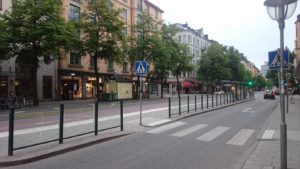
Odengatan, a major street in Stockholm, is about 100′ wide—about as wide as 14th Street in D.C. (Photo: Alon Levy.)
Another way to improve bus speed and reliability is for DDOT to create dedicated bus lanes and signal priority for buses, based on the principle that a bus with forty passengers should get forty times as much priority as a car with one driver and no passengers:
- Dedicated bus lanes, which let buses skip traffic, exist in a variety of forms. American cities that put up bus lanes usually put them on the curb side of the street, right next to the parking lanes, making it easier for buses to pick up passengers from the usual bus stops. ITDP recommends placing bus lanes in median lanes (see above), which move faster; this decision has its own tradeoffs, as transportation consultant Jarrett Walker has written. This can be controversial, as cities that are committed to giving public transit priority over cars often reduce streets to a single moving car lane in each direction.
- At intersections, buses can have signal priority. This means that the intersection is equipped with sensors that detect the presence of a bus, and change its light to green as it approaches. Like bus lanes, it is controversial, because of the inconvenience to drivers. But the effects on bus speeds are significant: in New York, buses that get signal priority are sped up by about 10%.
A comprehensive modernization of D.C.’s bus service would incorporate best industry practices
This piece outlines four ways WMATA and DDOT can modernize D.C.’s bus operations according to best industry practices. Some choices may be more politically difficult, such as giving buses priority on streets over car traffic. But combined with other changes such as off-board fare collection, this would give the District faster and more reliable bus service. There are also many opportunities for less controversial planning improvements, such as reconfiguring buses to allow more frequent service. This means pruning some branches in order to simplify service, making sure that passengers can easily understand where each bus goes without needing to use an app. The unbranched trunk routes can then run at a frequency that is high enough not to need a set schedule, such as on the 14th and 16th Street buses, or on a clockface schedule, such as every 15 or 30 minutes. It also means adding crosstown service and connecting to Metrorail stations better.
While these treatments are not groundbreaking or revolutionary, they have the potential to increase D.C.’s bus ridership after years of declining passenger use. Half-measures that focus on just one aspect, such as bus network design, have arrested the decline in bus ridership elsewhere in the United States, but have not led to any transit revival yet; bus ridership on the whole remains well below where it was just a few years ago. But full modernization and reform is likely to make buses fast and punctual enough to win large numbers of riders back, even those who can afford to buy a car or rely on private transportation options.
D.C. Policy Center Fellow Alon Levy grew up in Tel Aviv and Singapore. He has blogged at Pedestrian Observations since 2011, covering public transit, urbanism, and development. Now based in Paris, he writes for a variety of publications, including New York YIMBY, Streetsblog, Voice of San Diego, Railway Gazette, and the the Bay City Beacon. You can find him on Twitter @alon_levy.
